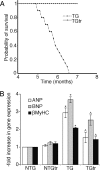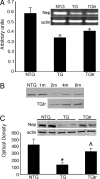Exercise reverses preamyloid oligomer and prolongs survival in alphaB-crystallin-based desmin-related cardiomyopathy
- PMID: 17389375
- PMCID: PMC1851605
- DOI: 10.1073/pnas.0609202104
Exercise reverses preamyloid oligomer and prolongs survival in alphaB-crystallin-based desmin-related cardiomyopathy
Abstract
The R120G mutation in the small heat shock-like protein alphaB-crystallin (CryAB(R120G)) causes desmin-related myopathy (DRM), which is characterized by the formation of desmin- and CryAB-containing aggregates within muscle fibers. Mice with cardiac-specific overexpression of CryAB(R120G) develop cardiomyopathy at 3 months and die at 6-7 months from heart failure (HF). Previous studies showed that overexpression of CryAB(R120G) results in accumulation of preamyloid oligomer (PAO). PAO is considered to be the cytotoxic entity in many of the protein misfolding-based neurodegenerative diseases. On the basis of data from mouse models of neurodegenerative diseases showing that exercise or environmental enrichment reduces the amyloid oligomer level and improves cognitive ability, we hypothesized that CryAB(R120G)-induced DRM would also respond favorably to prolonged voluntary exercise, reducing HF symptoms and rescuing the mice from premature death. Six months of voluntary exercise in CryAB(R120G) animals resulted in 100% survival at a time when all unexercised mice had died. After 22 weeks of exercise, PAO levels were decreased by 47% compared with the unexercised CryAB(R120G) control mice (P = 0.00001). Although CryAB(R120G) expression led to decreased levels of the metallomembrane endopeptidase neprilysin, normal levels were maintained in the exercised CryAB(R120G) mice, and in vitro loss-of-function and gain-of-function experiments using adenovirus-infected cardiomyocytes confirmed the importance of neprilysin in ameliorating PAO accumulation. The data demonstrate that voluntary exercise slows the progression to HF in the CryAB(R120G) DRM model and that PAO accumulation is mediated, at least in part, by decreased neprilysin activity.
Conflict of interest statement
The authors declare no conflict of interest.
Figures





Similar articles
-
Reversal of amyloid-induced heart disease in desmin-related cardiomyopathy.Proc Natl Acad Sci U S A. 2005 Sep 20;102(38):13592-7. doi: 10.1073/pnas.0503324102. Epub 2005 Sep 9. Proc Natl Acad Sci U S A. 2005. PMID: 16155124 Free PMC article.
-
Biochemical and mechanical dysfunction in a mouse model of desmin-related myopathy.Circ Res. 2009 Apr 24;104(8):1021-8. doi: 10.1161/CIRCRESAHA.108.193516. Epub 2009 Mar 19. Circ Res. 2009. PMID: 19299643 Free PMC article.
-
Desmin-related cardiomyopathy in transgenic mice: a cardiac amyloidosis.Proc Natl Acad Sci U S A. 2004 Jul 6;101(27):10132-6. doi: 10.1073/pnas.0401900101. Epub 2004 Jun 25. Proc Natl Acad Sci U S A. 2004. PMID: 15220483 Free PMC article.
-
Molecular mechanisms of α-crystallinopathy and its therapeutic strategy.Biol Pharm Bull. 2011;34(11):1653-8. doi: 10.1248/bpb.34.1653. Biol Pharm Bull. 2011. PMID: 22040875 Review.
-
Genetic modification of the heart: chaperones and the cytoskeleton.J Mol Cell Cardiol. 2004 Dec;37(6):1097-109. doi: 10.1016/j.yjmcc.2004.07.004. J Mol Cell Cardiol. 2004. PMID: 15572040 Review.
Cited by
-
Enhanced autophagy ameliorates cardiac proteinopathy.J Clin Invest. 2013 Dec;123(12):5284-97. doi: 10.1172/JCI70877. Epub 2013 Nov 1. J Clin Invest. 2013. PMID: 24177425 Free PMC article.
-
Designing Novel Therapies to Mend Broken Hearts: ATF6 and Cardiac Proteostasis.Cells. 2020 Mar 3;9(3):602. doi: 10.3390/cells9030602. Cells. 2020. PMID: 32138230 Free PMC article. Review.
-
Late-in-life treadmill training rejuvenates autophagy, protein aggregate clearance, and function in mouse hearts.Aging Cell. 2021 Oct;20(10):e13467. doi: 10.1111/acel.13467. Epub 2021 Sep 23. Aging Cell. 2021. PMID: 34554626 Free PMC article.
-
AlphaB-crystallin and breast cancer: role and possible therapeutic strategies.Cell Stress Chaperones. 2021 Jan;26(1):19-28. doi: 10.1007/s12192-020-01175-0. Epub 2020 Oct 28. Cell Stress Chaperones. 2021. PMID: 33111264 Free PMC article. Review.
-
Transcription Factor EB Activation Rescues Advanced αB-Crystallin Mutation-Induced Cardiomyopathy by Normalizing Desmin Localization.J Am Heart Assoc. 2019 Feb 19;8(4):e010866. doi: 10.1161/JAHA.118.010866. J Am Heart Assoc. 2019. PMID: 30773991 Free PMC article.
References
-
- Goldfarb LG, Vicart P, Goebel HH, Dalakas MC. Brain. 2004;127:723–734. - PubMed
-
- Ferreiro A, Ceuterick-de Groote C, Marks JJ, Goemans N, Schreiber G, Hanefeld F, Fardeau M, Martin JJ, Goebel HH, Richard P, et al. Ann Neurol. 2004;55:676–686. - PubMed
-
- Vicart P, Caron A, Guicheney P, Li Z, Prevost MC, Faure A, Chateau D, Chapon F, Tome F, Dupret JM, et al. Nat Genet. 1998;20:92–95. - PubMed
-
- Wang X, Osinska H, Klevitsky R, Gerdes AM, Nieman M, Lorenz J, Hewett T, Robbins J. Circ Res. 2001;89:84–91. - PubMed
-
- Kopito RR. Trends Cell Biol. 2000;10:524–530. - PubMed
Publication types
MeSH terms
Substances
Grants and funding
LinkOut - more resources
Full Text Sources
Other Literature Sources
Medical
Molecular Biology Databases
Research Materials
Miscellaneous

